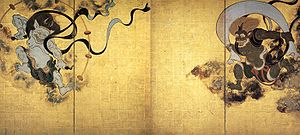Japanese Painting
 From Conservapedia - Reading time: 3 min
From Conservapedia - Reading time: 3 min

Painting (絵画) is one of the oldest Japanese art, and the most popular one. It was influenced by Chinese painting (Buddhist religious painting, landscapes in the Chinese tradition), and from the later 19th century onwards by Western art. Main Painting Schools have been: Suibokuga, Kanō, Rimpa, Tosa-ha, Nanga and Shijo. Japanese paintings may evoke an association with landscapes and natural scenes drawn with a few genial brush strokes. The impression may come from the majority of the scroll paintings that are to be found in galleries and museums. [1]
Subject matter includes calligraphic images and Zen themes, landscapes and views, beautiful women and Noh and Kabuki theater settings and scenes from the Imperial court as well as everyday life. [2]
Japanese interpretations and painters may be studied in the following periods:
- Ancient Japan
- Monochrome pottery, cord-impressed designs (Jomon) and lacquer objects.
- Nara period
- Painting in this period emulated Chinese T'ang prototypes.
In the fifth century the Buddhism culture reached Japan, and the Chinese style painting rooted in Japan. Not only the influence of China but also that of the Buddhist mural painting in India is left to the Horyuji Hekiga (Mural paintings of Horyuji temple) , it teaches us the roots of the Buddhist art. [3]
- Heian and Kamakura periods
- Tokiwa Mitsunaga (ca. last half of the 12th century) Narrative Handscrolls.
When it was the tenth century, the Japanese picture began to leave Chinese strong influence and tied to racial sensitivity and created styles called the Yamato-e... The Picture scroll of Genji tale in the Heian era is the typical of that. Ibidem
- Muromachi period
- Josetsu (如拙) (1405 – 1423), the father of Japanese ink painting.
- Sesso Toyo (1420-1506)
- Azuchi-Momoyama period
- Kanō Eitoku (狩野 永徳) (1543 - 1590), prominent patriarch of the Kanō School.
- Edo period
- Tawaraya Sōtatsu (俵屋宗達) (c. 1600s), co-founder of the Rimpa School.
- Hakuin Ekaku (1685-1768), had a profound effect on Zen painting.
- Sekkan Sakurai (1715-1790)
- Sukoku Toryuo (1730-1804)
- Maruyama Okyo (1733-95), the founder of the Maruyama-Shijo school of naturalist painters in Kyoto.
- Katsushika Hokusai (葛飾北斎) (1760 — 1849), Ukiyo-e (浮世絵) genre painter and printmaker. "Behind the Great Wave at Kanagawa" (c.1829) is one of the most renowned Japanese paintings.
- Nakabayashi Chikuto (1776-1853)
- Keibun Matsumura (1779-1843)
Famous globally were: Kitagawa Utamaro (ca. 1753 - 1806, works for illustrated books), Ando Hiroshige (1797-1858, favorite of the Impressionists), Katsushika Hokusai (1760-1849, Behind the Great Wave at Kanagawa, one of 150 different prints of Mt. Fuji; The Mt. Fuji paintings were parts of a collection called One Hundred Views of Mt. Fuji and Thirty-six Views of Mt. Fuji.), and Toshusai Sharaku (famous for his portraits of kabuki actors). [4]
- Meiji period
- Shoen Uemura (1875-1949), female painter.
As the national isolation of Japan was over by the Meiji Restoration (1868) and came to join the global community, the Western art flowed in one after another Japanese painter. Ibidem
- Taisho period
- Taikan Yokoyama (1868-1958), member of the samurai class of the Mito clan.
- Showa period
- Kaii Higashiyama (1908-1999)
- Yuki Ogura (小倉遊亀) (1895 - 2000), traditional female painter.
- Contemporary period
- Shinoda Toko (篠田桃紅) (b. 1913), female painter, sumi (ink) paintings and prints.
- Takashi Murakami (村上隆) (1963 - )
Katsushika Hokusai was celebrated as a great print designer, book illustrator, and painter. His works had a deep and lasting effect not only on Japanese art but also on modern Western art. Hokusai was the first Japanese printmaker who endeavored to show the spectrum of human types and experiences in his work, and he was also the first to produce a significant series of pure landscape prints. [5]
Tateishi Harumi, Clover, 1934.
 KSF
KSF







